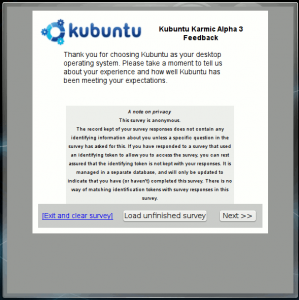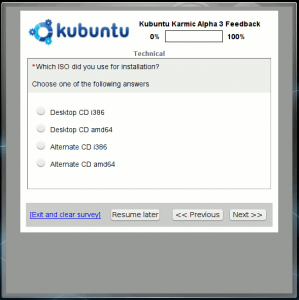Yesterday I decided that I would start tackling the QA side of things on the Todo List for Kubuntu Karmic. So with that I will be creating a QA policy for Kubuntu, which I am sure I build off of the current policies and guidelines for Ubuntu and other distros, since the work is already done pretty much, for the GNOME side of things. That’s what hackers do right? We hack together stuff until we get what we want 🙂
Well, one of the projects I have been tasked with is to create some sort of feedback system for Kubuntu. In the past we had utilized the wiki but this ended up being more of an inconvenience than anything. What would happen is on release day, everyone goes and gets their fresh Kubuntu download, and heads over to do some feedback. You know what happens when multiple people start editing a wiki page at the same time without realizing that it is locked by another user. CONFLICTS! So with that said, I headed on out to start working on some sort of feedback system that we could access with a plasmoid. After researching my options, which unbelievably there aren’t many, I landed my first alpha release utilizing Lime Survey (an awesome open source survey application) and created a quick plasmoid utilzing Plasma.WebView in Python. Literally, the plasmoid took me about 5 minutes from start to finish, it is that crude and simple right now.
Here are a couple screenshots of what it currently looks like in action:
It works, so that qualified it for a quick alpha to let people see it in action and hopefully come up with some ideas.
I have come up with a couple of ideas for the plasmoid because of a simple design flaw. Utilizing the plasmoid will only work during a Live CD session or after Kubuntu is installed and running. Now we all know that during a development cycle not everyone can have the luxury of a Live CD or an install going as planned. Because of this, the plasmoid would be useless, therefor causing us to go back to an archaic method of filling in the feedback. The Internet! At least we have the Internet. Some things I would also like to incorporate, which is probably just another 5 minutes with the plasmoid, is the ability to work on the survey offline, and then syncing as soon as you come online.
So with that said now, I decided that the Linux desktop platforms could really use a good feedback application. One that ties into the desktop and submits results back to a central location. So I got to thinking. How about doing it like 5-a-day is done using bzr? Nah, then I thought some more. How about something like the Ubuntu and Debian Popularity Contest? OK, so the backend/server/database part would be fairly simple and straight forward. Now the frontend part. How would the application work? So I thought about XML files that contained the feedback questions and configuration. So far, this makes the most sense, but isn’t XML such a pain, the ball-and-chain for Python? I have so many ideas on how to go forth with this, now I just need to make some time and start playing around with ideas. What do you all think?
Once it is downloaded, you can install it by using the “Add Widgets” dialog or via the command line by doing:
plasmapkg -i kubuntu-qa-feedback.plasmoidThen you can add it to your desktop using the “Add Widgets” dialog or test it out via the command line by doing:
plasmoidviewer kubuntu-qa-feedback
That’s it from me tonight, goodnight world and happy hacking!



